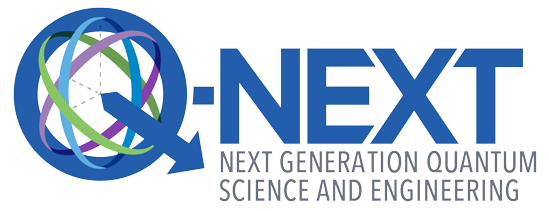Q-NEXT brings together the world’s leading minds from the national laboratories, universities and technology companies to solve cutting-edge challenges in quantum information science. Led by the U.S. Department of Energy’s Argonne National Laboratory, Q-NEXT focuses on how to reliably control, store and transmit quantum information at distances that could be as small as the width of a computer chip or as large as the distance between Chicago and San Francisco. Advances in quantum information science have the potential to revolutionize how we process and share information, with profound impacts such as advanced medical imaging, the creation of novel materials and ultrasecure communication networks. Through its partnerships, Q-NEXT is creating an innovation ecosystem that enables the translation of discovery science into technologies for science and society.
We bring together national experts and facilities to solve cutting-edge challenges in quantum information science
Innovative research
Q-NEXT focuses on quantum communication to distribute information robustly over long distances; quantum sensors, enabling ultraprecise measurements; quantum materials for building groundbreaking technologies; and quantum simulators to support the development of quantum computers.
A vibrant quantum ecosystem
National labs, universities and technology companies are partners in Q-NEXT. These organizations bring together world-leading experts in multiple areas of research, top-tier facilities, and cutting-edge projects and collaborations to advance the state of the art in quantum information science and technology.
Quantum foundries
The Q-NEXT team is building two national quantum foundries, one at Argonne and the other at SLAC National Accelerator Laboratory. These foundries will serve as a quantum factory, producing a robust supply chain of high-quality, standardized materials and devices that will support quantum-enabled applications.
The next-generation workforce
Q-NEXT is working to develop our nation’s future quantum workforce through innovative cooperative training programs with industry, quantum-focused institutional degree programs at the center’s university partners, and re-training certificate programs to build foundational skills for quantum careers.
Q-NEXT by the numbers
3 national labs
11 universities
14 leading technology companies
100 researchers
2 quantum foundries
9 states
Areas advanced by Q-NEXT R&D
Telecommunications
Energy
Financial services
Materials and chemicals
Pharmaceuticals
Transportation and logistics
Featured news
-
Design rules and synthesis of quantum memory candidates
From the University of Illinois Urbana-Champaign: Researchers use density functional theory calculations to identify possible europium compounds to serve as a new quantum memory platform. They also synthesize one of the predicted compounds, a brand new, air-stable material that is a strong candidate for use… Read More
-
‘Ruler for light’ could enable detailed measurement in personal devices
Frequency combs have revolutionized precision measurement, but the bulky, power-hungry devices are limited to lab settings. A new efficient laser “microcomb” developed by Stanford researchers could bring that revolution to the handheld electronics realm. Read More
-
Resurrecting niobium for quantum science
For years, niobium was considered an underperformer when it came to superconducting qubits. Now scientists supported by Q-NEXT have found a way to engineer a high-performing niobium-based qubit and so take advantage of niobium’s superior qualities. Read More
In the news
-
The best qubits for quantum computing might just be atoms
From Quanta: Mark Saffman of the University of Wisconsin–Madison and Infleqtion is featured in this comprehensive overview of neutral-atom qubit research. Read More
-
How quantum computing could help us understand the universe
From PBS NewsHour: David Awschalom appears in this piece on the next generation of computing, one that will be far more sophisticated and dependent on understanding the subatomic nature of the universe. Read More
-
PME-led research into protein-based qubits earns $2.75M Moore Foundation grant
Bolstered by a new $2.75 million grant from the Gordon & Betty Moore Foundation, a team led by University of Chicago's Peter Maurer will soon study qubits made from protein. Read More
